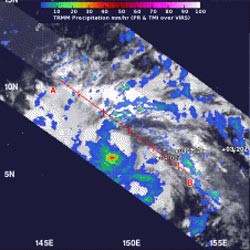NASA Investigates Typhoon Haiyan's Intense Rainfall

On Nov. 4, NASA's TRMM satellite found precipitation falling at a rate of about 50 and 60 mm/1.9 and 2.3 inches per hour near Typhoon Haiyan's center and between 10 and 30 mm/0.39 and 1.18 inches per hour outside the center. <br>Image Credit: NASA/SSAI, Hal Pierce<br>
NASA's Tropical Rainfall Measuring Mission satellite known as TRMM passed over Typhoon Haiyan on Nov. 4 at 1042 UTC/5:42 a.m. EDT. TRMM's Precipitation Radar instrument provided data on rainfall in the storm's northeastern quadrant.
Rainfall near the center appeared to be falling at a rate of between 50 and 60 mm/1.9 and 2.3 inches per hour. Rainfall outside the center was falling between 10 and 30 mm/0.39 and 1.18 inches per hour. TRMM also saw that some of the thunderstorms were reaching heights over 10 km/6.2 miles high.
On Nov. 5 at 1500 UTC, Haiyan's maximum sustained winds increased to 90 knots/103.6 mph/166.7 kph, and are forecast to increase more over the next several days. Haiyan is centered near 6.9 north and 142.3 east, about 333 nautical miles/ 383.2 miles/616 km east-southeast of Yap. The typhoon is moving to the west-northwest at 15 knots/ 17.2 mph/27.7 kph.
A Typhoon Warning is in effect for Kayangel in the Republic of Palau and Ngulu in Yap State, and a Typhoon Watch is in effect for Fais, Ulithi, in Yap State. In addition, a Tropical Storm Warning remains in effect for Yap Island in Yap State and Koror in Palau.
Forecasters at the Joint Typhoon Warning Center or JTWC who provide the bulletins and forecasts on the storm noted on Nov. 5 that animated enhanced infrared satellite imagery showed the Haiyan was intensifying quickly and bands of thunderstorms wrapping into the center were strengthening. There was a strong band of thunderstorms wrapping around the western semi-circle and into an eye detected by microwave satellite data.
JTWC expects the storm to intensify rapidly over the next two to three days as it moves through the Philippine Sea.
Text credit: Rob Gutro
NASA's Goddard Space Flight Center
Media Contact
All latest news from the category: Earth Sciences
Earth Sciences (also referred to as Geosciences), which deals with basic issues surrounding our planet, plays a vital role in the area of energy and raw materials supply.
Earth Sciences comprises subjects such as geology, geography, geological informatics, paleontology, mineralogy, petrography, crystallography, geophysics, geodesy, glaciology, cartography, photogrammetry, meteorology and seismology, early-warning systems, earthquake research and polar research.
Newest articles

High-energy-density aqueous battery based on halogen multi-electron transfer
Traditional non-aqueous lithium-ion batteries have a high energy density, but their safety is compromised due to the flammable organic electrolytes they utilize. Aqueous batteries use water as the solvent for…

First-ever combined heart pump and pig kidney transplant
…gives new hope to patient with terminal illness. Surgeons at NYU Langone Health performed the first-ever combined mechanical heart pump and gene-edited pig kidney transplant surgery in a 54-year-old woman…

Biophysics: Testing how well biomarkers work
LMU researchers have developed a method to determine how reliably target proteins can be labeled using super-resolution fluorescence microscopy. Modern microscopy techniques make it possible to examine the inner workings…





















